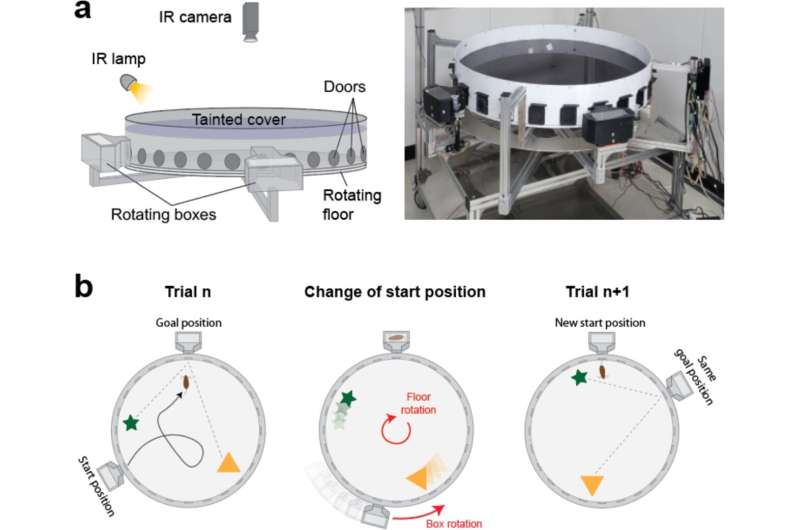This article has been reviewed according to Science X's editorial process and policies. Editors have highlighted the following attributes while ensuring the content's credibility:
fact-checked
peer-reviewed publication
trusted source
proofread
Neural processes study sheds new light on how animals navigate their environment

Scientists have demonstrated how mice choose between three different strategies to navigate through their surroundings towards a goal.
Their study, published as an eLife Reviewed Preprint, provides what the editors describe as a valuable new behavioral apparatus for differentiating the strategies animals use to orient themselves in an environment.
Animals can use a number of different strategies, or a combination of them, to move through their surroundings. How they select these strategies based on the nature and familiarity of their environment is unclear.
One way of studying this is by using the Barnes maze, in which rodents explore a circular arena until they find an escape box located under one of several holes along the outskirts of the arena. Simple criteria, such as the number of visited holes, are used to classify the strategy employed by mice in each trial of the maze.
"Typical Barnes mazes work under the assumption that the same strategy is maintained across a whole trial, so it is unclear whether they accurately capture the full range of navigational strategies used by mice," explains co-lead author Ju-Young Lee, a Ph.D. student at the Brain Science Institute, Korea Institute of Science and Technology (KIST), Seoul, Republic of Korea.
To address this shortcoming, Lee and colleagues developed an automated variant of the Barnes Maze, which allowed them to randomize the start and goal positions for each individual trial, without interfering with the experiment.
"Our maze is similar to the Barnes maze in that mice explore an open arena and navigate to a goal chosen among 24 doors evenly spaced along the edge of the arena," says co-lead author, Dahee Jung, Postdoc at the Brain Science Institute, KIST. "The difference with ours is that it features two luminous objects inside the arena as orienting cues, and the mice start at the edge, instead of the center."
The team monitored the trajectories of 10 male and 10 female mice completing the maze over 15 days. During this time—the acquisition phase—the mice performed 10 trials per day. Next, the team performed a probe test, in which the goal door remained closed and mice were allowed to explore the arena for two minutes. Finally, for a further four days—the reversal phase—the mice performed the same task as in the acquisition phase, but with a different goal location.
Despite the differences in the maze set up, the team found that the learning rates and spatial strategies used by the mice were comparable to those reported in the traditional Barnes maze. Over the course of the acquisition phase, mice progressively visited less vestibules, heading towards the goal vestibule quicker.
To determine whether they relied on visual cues to find the goal, the researchers analyzed the proportion of visits to each vestibule. This revealed a preference for vestibules in the vicinity of the goal location over the course of the acquisition phase, supporting the theory that the mice used the luminous markers to gain spatial information.
The team considered that mice used three navigational strategies to reach their goal: random, spatial, and serial search (where they visited consecutive vestibules in a row). They next used models to perform simulations to explain which search strategy was responsible for the patterns of vestibules visited by the mice. Simulations for each individual strategy were not able to reproduce the experimental results individually, so the team developed models that combined all three strategies.
In one of these models, mice chose one of the strategies at the beginning of the trial and then each time they completed a particular number of segments. This model best replicated the data from the team's experiments, demonstrating for the first time that the patterns of vestibule visits could be explained by a combination of all three navigational strategies.
eLife's editors say that it is important to further investigate how strategy development varies between individual mice. This could be done by measuring the changes in strategy across days for each individual mouse and analyzing how the population average—based on the data from the individual mice—corresponds to these findings.
"Our study provides a novel version of the Barnes maze and analytical tools that have allowed us to track the repertoire of navigation strategies in mice over time," concludes senior author Sébastien Royer, a Principal Investigator at the Brain Science Institute, KIST. "These tools could be combined in the future with optogenetic and/or pharmacogenetic approaches to investigate the neural mechanisms underlying strategy selection in a given environment."
More information: Ju-Young Lee et al, Stochastic characterization of navigation strategies in an automated variant of the Barnes maze, eLife (2023). DOI: 10.7554/eLife.88648.1



















